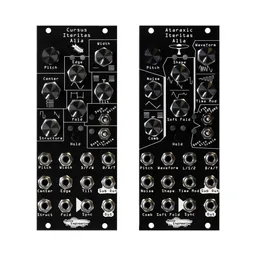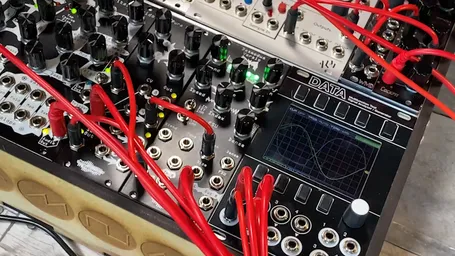As we’re sure you’ve seen, we’ve announced four new modules: Lapsus Os, Pons Asinorum, Roti Pola, and Sinc Defero. And now they are available for preorder, shipping Dec 7!

They’re a whole lot of fun. These releases focus more on utility and expanding the possibilities of other modules in your rack with a slew of new ways to generate, modify, and control CV.
Here the whole NE gang talks a bit about the history and inspiration for each, as well as some of our favorite uses and applications.
Lapsus Os
LO started life as a simple performance module for Stephen’s case, but with a much reduced featureset, designed primarily for hands-on control of other modules. Initially, many of the features were redundant (there were 16 outputs on the first couple of versions, for example), and we realized much more could be done to make it a better performance-oriented CV manipulator. We sat on this one for some time (many of you have seen this in Stephen’s live jams for a long time now). A few months ago, we got moving on it again, and a few revisions later, it evolved into the design we have now: four faders that can control other modules either via internal 5v offset or by attenuating/inverting/offsetting other CV sources. With the dipswitches on the back each channel can be inverted, and the module can be mounted whatever direction makes sense in your case.
We really like using LO on envelopes. We each do a lot of “traditional” patches with an envelope controlling a filter, and being able to control the amount the filter opens with a fader opens up some really cool accent and performance possibilities. LO also pairs perfectly with Mimetic Digitalis, and running MD into LO and out to something like the Ataraxic Iteritas creates a perfect modulation control surface.
Pons Asinorum
Let’s face it: you can always use more envelopes. That’s how that saying goes, right?
PA was inspired by some friends of Noise Engineering. Sky King of Buck Modular fame had suggested we make a small quad decay module. We went through a couple revisions and the module (then called Sinc Mori) languished apart from being the main envelope in Stephen’s case. When NE friend Dave Driggers mentioned the name of his band, Pons Asinorum, we realized what we needed to do: expand the functionality beyond just decay. It took a few hardware revisions, and a LOT of firmware tweaking but eventually, that turned into the PA we have today: a quad attack/attack-decay/decay with looping, CV over cycle length, and performance-oriented controls. Having CV over envelope length makes for basically endless possibilities. Markus makes a lot of acid basslines and being able to sequence accented notes with longer envelopes is invaluable (have you noticed they like accents?). Being able to control multiple different cycle lengths separately-but-together on one encoder makes for some awesome performance control as well: start out with four short voices, and slowly bring them in with the turn of a single knob. Kris is obsessed with the LFO functions and has been having a ton of fun with those in compact and easily controlled form. And because each channel can be independently controlled, you can pick and choose how you use each one. How handy is that? At this point, we’re basically never not using all four channels of our PAs.
Roti Pola
CV mixing is really fun. Like, really fun. There’s a lot of cool stuff you can do with it, too. RP was inspired by our friend Baseck, who showed us how he used different CV sources to create percussive patches out of our oscillators. We knew we had to make our own CV mixer but with a classic NE twist (i.e. lots of blinkenlights and a cool panel). Our initial design worked well enough but had some kind of stupid layout issues that we had a collective facepalm about when we got the thing in our hands. Making a whole new revision was not terribly palatable (it’s expensive, and while prepping a new RP would comparably little time, it’s still time we could spend elsewhere)...but then we realized we could add the 5v offset to the first channel, effectively making it its own CV source. That was the kick in the pants we needed to make the next version, and we were pretty happy with that.
There are tons and tons of great uses for CV mixing. Since RP can attenuate, invert, and offset any signal the possibilities are quite broad. One of my favorite uses is creating unusual and organic shapes of envelopes. Patching one short and one long decay envelope from, say, Pons Asinorum (more on that one below) and mixing them together at different strengths makes for an extremely useful and weird-shaped envelope that is actually great for creating pseudo-real-world sounds. Most Noise Engineering oscillators have controls that add harmonics the higher the value of the input CV (like Fold on Loquelic Iteritas) and patching an envelope shaped like this into that kind of parameter is very useful. Think about how a bass or guitar sounds: there’s a lot of harmonic content right when the string is initially plucked (here created by the short, strong envelope), but that goes away quickly and the lower-level harmonics and amplitude of the string slowly fade (created here by the longer, softer envelope). With Channel 1’s offset an envelope like this can be set perfectly, and you may be surprised by the results you can get with this technique and an oscillator like Cursus Iteritas.
Also it works as a perfectly acceptable audio submixer in a pinch.
Sinc Defero
Let’s face it, attenuators can be boring. There’s nothing new to say here: Signal goes in and gets attenuated…or doesn’t. Ok! But the passive attenuators on the market tend to drop their output signal significantly, especially when sent to multiple destinations. Boring AND problematic? Something had to be done.
That’s where the SD came in. It’s buffered, it gives visual feedback for both the input AND output so you always know exactly what’s going on, and it’s compact and won’t break the bank. What’s not to love?
We all know what attenuation does, but here are a couple of our favorite uses. First, on Loquelic Iteritas (and really all of the Iteritas oscillators), the smallest adjustment to any parameter can make a huge tonal difference. Sending a 5v envelope to an LI parameter tends to be overwhelming. Being able to scale that down allows for precise and delicate modulation that really wakes up a patch (and helps avoid noisy chaos, which, you know, is also fun. So maybe allows you to control noisy chaos?). Kris uses an attenuator in almost every case she ever puts together.
Markus uses it a lot for helping with creating accents. They use an Erica Synths Drum Sequencer for a lot of their percussion sequencing, and like most other percussion-oriented sequencers it has accent outputs for each trigger. When they're doing normal percussion stuff they run the accent out through SD and into the Decay parameters on their Basimilus Iteritas Alters (yes, that’s plural. Because everyone needs plural BIA.) to create more dynamic kicks, snares, and hats. A small difference in the Decay (or any other parameter, for that matter) makes for a big difference in a drum sequence and keeps things from getting stagnant.
In conclusion, buy them all please
There you have it. Four new modules! We’ve been busy. Pretty crazy. And I mean, we’re not biased or anything, but they’re all budget, skiff, and HP friendly. Shocking! They integrate really nicely into any system and will greatly expand the functionality of the other modules in your NE system (you have one, don’t you?). Also, with all these LEDs, you’re basically investing in mood lighting for your studio. Who needs expensive lamps? It sounds like buying these modules is winning all around…
All these modules will be available December 7, but preorders are open now!






